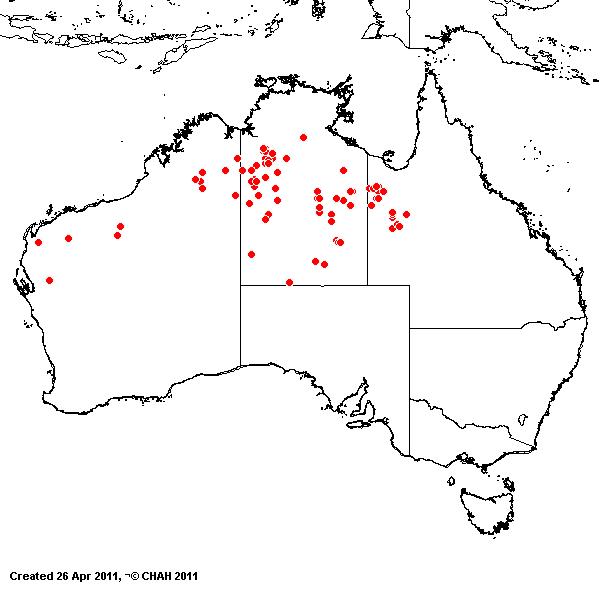Eragrostis desertorum Domin. Biblioth.
Bot. 85: 404 (1915).
Classification. (GPWG 2001) : Subfamily
Chloridoideae. Cynodonteae.
Type of Basionym or
Protologue Information: West Queensland:
durre Hugel bei Cloncurry, Feb 1910, Domin s.n..
Key references
(books and floras): [1952] C.A.Gardner, Flora of Western Australia 1
Gramineae (124), [2002] D.Sharp & B.K.Simon, AusGrass, Grasses of
Australia, [2008] S.W.L.Jacobs, R.D.B.Walley & D.J.B.Wheeler, Grasses
of New South Wales (250 not NSW).
Illustrations:
[1952] C.A.Gardner, Flora of Western
Australia 1 Gramineae (127, Pl. 37),
[2008] S.W.L.Jacobs, R.D.B.Whalley & D.J.B.Wheeler, Grasses of New South
Wales, 4th edn (250).
Habit.
Perennial. Stolons present. Culms erect, 30–60 cm tall. Leaves mostly basal.
Ligule a fringe of hairs, 0.7–1 mm long. Leaf-blades straight, filiform,
conduplicate or involute or convolute, 5–12 cm long, 1–2 mm wide.
Inflorescence.
Inflorescence compound, a panicle. Panicle lanceolate or ovate, 12–18 cm long.
Spikelets.
Spikelets pedicelled. Fertile spikelets many flowered, with at least 2 fertile
florets (8–56), comprising 8–56 fertile floret(s), with diminished florets at
the apex, linear or lanceolate, terete, 4–25 mm long.
Glumes. Glumes
similar. Lower glume oblong, membranous, keeled, 1-keeled, 1 -nerved. Upper
glume oblong, 1.2–1.5 mm long, membranous, keeled, 1-keeled, 1 -nerved.
Florets.
Fertile lemma 1–1.5 mm long, without keel or keeled, 3 -nerved. Lemma apex
muticous. Lodicules present. Anthers 2.
Continental
Distribution: Australasia.
Australian
Distribution: Western Australia, Northern Territory, Queensland.
Western Australia: Canning,
Keartland, Fortescue. Northern Territory:
Barkly Tableland, Central Australia North, Central
Australia South. Queensland:
Burke, Gregory North.
Notes.
Distinguishing characters include bulbous or rhizomatous, woolly or hirsute
base; ciliate leaf sheaths; stiffly subulate blades; wiry culms; roughened
indumentum on culms and leaves; ciliate ligule; deciduous florets; dorsally
rounded lemmas; long paleas relative to lemmas, with 3-toothed apex; two
stamens; subterete caryopsis.
Resembles E. eriopoda, but stamens two
and differing also in morphology of spikelets, especially lemma and caryopsis,
and indumentum of foliage.
Endemic;
occurs in W.A. S of Exmouth on the W coast and in the Wolf Ck Crater and Ord R.
areas to the N, then widespread across central N.T. to Cloncurry and Mt Isa in
Qld. Commonly associated with limestone; in clayey swales of sandhills, deep
red sands and loams, on skeletal hillslopes; in low-lying seasonally wet
habitats such as creek fans and banks, gullies and valleys.; flowers Mar.-Aug.
and Nov.-Jan.; fruits Mar.-Aug. and Nov.-Jan.



